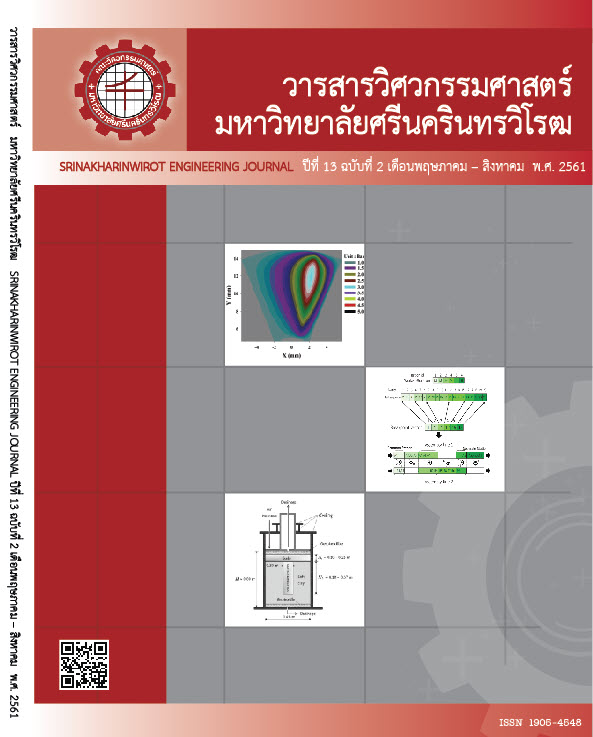Application of Differential Evolutionary Algorithm to Compare the Performance of Continuous Multi-Objective Problem Optimization
Main Article Content
Abstract
Decomposition is a basic strategy in traditional multi-objective optimization. At present, it has been interested and widely used in multi-objective evolutionary optimization. This article proposes an adaptive MOEA/D hybridized with differential evolution (AMOEA/D-DE). The concept is based on a multi-objective evolutionary algorithm based on decomposition (MOEA/D) and adaptive differential evolution algorithm (ADE). It decomposes a multi-objective problems (MOPs) into a number of scalar optimization subproblems (decomposes a MOPs into several SOPs) and optimizes them simultaneously with adjustment of control parameters and strategies to achieve a diversity of approximated true non-dominated solutions. Each subproblem is optimized by using information from its several neighboring subproblems, which makes AMOEA/D-DE had lower computational complexity and adapt itself to the current search requirements. In experiments, AMOEA/D-DE is compared with a MOEA/D and a multi-objective differential evolution algorithm based on decomposition (MODE/D) in order to solve continuous MOPs. The result from experiments show that AMOEA/D-DE outperforms the others in terms of convergence rate but it takes more time consumption when compared to the equivalent number of function evaluations.
Article Details
Copyright belongs to Srinakharinwirot University Engineering Journal
References
[2] D. Brockhoff and E. Zitzler, "Objective reduction in evolutionary multi-objective optimization: Theory and applications," Evolutionary Computation, vol. 17, no. 2, pp. 135-166, 2009.
[3] Q. Zhang and H. Li, "MOEA/D: A multiobjective evolutionary algorithm based on decomposition," IEEE Transactions on evolutionary computation, vol. 11, no. 6, pp. 712-731, 2007.
[4] H. Li and Q. Zhang, "A multiobjective differential evolution based on decomposition for multiobjective optimization with variable linkages," in Parallel problem solving from nature-PPSN IX: Springer, 2006, pp. 583-592.
[5] K. Miettinen, "Nonlinear Multiobjective Optimization, volume 12 of International Series in Operations Research and Management Science," ed: Kluwer Academic Publishers, Dordrecht, 1999.
[6] M. Ehrgott, "A discussion of scalarization techniques for multiple objective integer programming," Annals of Operations Research, vol. 147, no. 1, pp. 343-360, 2006.
[7] H. Li and Q. Zhang, "Multiobjective optimization problems with complicated Pareto sets, MOEA/D and NSGA-II," IEEE Transactions on evolutionary computation, vol. 13, no. 2, pp. 284-302, 2009.
[8] Q. Zhang, W. Liu, E. Tsang, and B. Virginas, "Expensive multiobjective optimization by MOEA/D with Gaussian process model," IEEE Transactions on Evolutionary Computation, vol. 14, no. 3, pp. 456-474, 2010.
[9] R. Storn and K. Price, "Differential evolution–a simple and efficient heuristic for global optimization over continuous spaces," Journal of global optimization, vol. 11, no. 4, pp. 341-359, 1997.
[10] S. M. Venske, R. A. Gonçalves, and M. R. Delgado, "ADEMO/D: Multiobjective optimization by an adaptive differential evolution algorithm," Neurocomputing, vol. 127, pp. 65-77, 2014.
[11] K. Price, R. M. Storn, and J. A. Lampinen, Differential evolution: a practical approach to global optimization. Springer Science & Business Media, 2006.
[12] A. K. Qin and P. N. Suganthan, "Self-adaptive differential evolution algorithm for numerical optimization," in Evolutionary Computation, 2005. The 2005 IEEE Congress on, 2005, vol. 2, pp. 1785-1791: IEEE.
[13] J. Brest, S. Greiner, B. Boskovic, M. Mernik, and V. Zumer, "Self-adapting control parameters in differential evolution: A comparative study on numerical benchmark problems," IEEE transactions on evolutionary computation, vol. 10, no. 6, pp. 646-657, 2006.
[14] J. Teo, "Exploring dynamic self-adaptive populations in differential evolution," Soft Computing, vol. 10, no. 8, pp. 673-686, 2006.
[15] V. L. Huang, A. K. Qin, and P. N. Suganthan, "Self-adaptive differential evolution algorithm for constrained real-parameter optimization," in Evolutionary Computation, 2006. CEC 2006. IEEE Congress on, 2006, pp. 17-24: IEEE.
[16] X. Yao, Y. Liu, and G. Lin, "Evolutionary programming made faster," IEEE Transactions on Evolutionary computation, vol. 3, no. 2, pp. 82-102, 1999.
[17] C.-Y. Lee and X. Yao, "Evolutionary programming using mutations based on the Lévy probability distribution," IEEE Transactions on Evolutionary Computation, vol. 8, no. 1, pp. 1-13, 2004.
[18] J. Liu and J. Lampinen, "A fuzzy adaptive differential evolution algorithm," Soft Computing, vol. 9, no. 6, pp. 448-462, 2005.
[19] J. Zhang and A. C. Sanderson, "JADE: adaptive differential evolution with optional external archive," IEEE Transactions on evolutionary computation, vol. 13, no. 5, pp. 945-958, 2009.
[20] S. M. S. Venske, R. A. Goncalves, and M. R. Delgado, "ADEMO/D: Adaptive Differential Evolution for Multiobjective Problems," presented at the 2012 Brazilian Symposium on Neural Networks, 2012.
[21] J. Zhang and A. C. Sanderson, Adaptive Differential Evolution: A Robust Approach to Multimodal Problem Optimization. Scientific Publishing Services Pvt. Ltd., Chennai, India., 2009, p. 163.
[22] Q. Lin, Q. Zhu, P. Huang, J. Chen, Z. Ming, and J. Yu, "A novel hybrid multi-objective immune algorithm with adaptive differential evolution," Computers & Operations Research, vol. 62, pp. 95-111, 2015.
[23] E. Zitzler, K. Deb, and L. Thiele, "Comparison of multiobjective evolutionary algorithms: Empirical results," Evolutionary computation, vol. 8, no. 2, pp. 173-195, 2000.
[24] K. Deb, L. Thiele, M. Laumanns, and E. Zitzler, "Scalable multi-objective optimization test problems," in Evolutionary Computation, 2002. CEC'02. Proceedings of the 2002 Congress on, 2002, vol. 1, pp. 825-830: IEEE.
[25] K. Deb, Multi-objective optimization using evolutionary algorithms. John Wiley & Sons, 2001.
[26] E. Zitzler, L. Thiele, M. Laumanns, C. M. Fonseca, and V. G. Da Fonseca, "Performance assessment of multiobjective optimizers: An analysis and review," IEEE Transactions on evolutionary computation, vol. 7, no. 2, pp. 117-132, 2003.
[27] S. Jiang, Y. S. Ong, J. Zhang, and L. Feng, "Consistencies and contradictions of performance metrics in multiobjective optimization," IEEE Trans Cybern, vol. 44, no. 12, pp. 2391-404, Dec 2014.
[28] A. Ibrahim, S. Rahnamayan, M. V. Martin, and K. Deb, "3D-RadVis: Visualization of Pareto front in many-objective optimization," in Evolutionary Computation (CEC), 2016 IEEE Congress on, 2016, pp. 736-745: IEEE.


